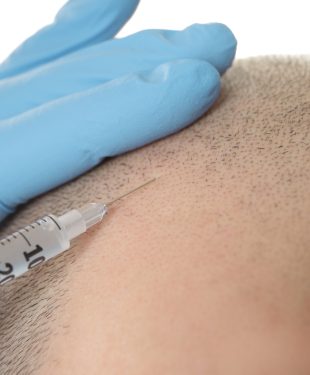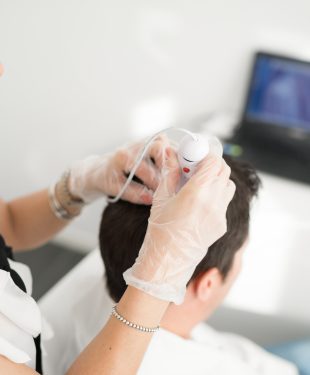
Today we want to talk about DHI Hair Transplant procedure and risks. Hereditary factors, as well as aging, stressful experiences, and a variety of medical illnesses, can all contribute to hair loss. Nonetheless, owing to the technology we currently have, things can be reversed.
This procedure can be done on anybody who has a substantial number of hair follicles, independent of the cause of hair loss, using hair transplantation surgery. The transplanting procedure is effective not just on the scalp, but also on other parts of the body such as the brows, moustache, and beard.
As a result, we now have the opportunity to change the rules of the game in our favor.
What Is Dhi Hair Transplant?
 DHI hair transplantation is a method of implantation that uses an implanter pen injector. Following the removal and screening of suitable grafts from donor sites, they are implanted in the intended receptor region.
DHI hair transplantation is a method of implantation that uses an implanter pen injector. Following the removal and screening of suitable grafts from donor sites, they are implanted in the intended receptor region.
DHI Hair Transplant, on the other hand, is a more advanced hair transplant procedure in which hairs are taken one at a time from the giving body part using a high-quality remover before being placed directly on the bald areas of the scalp.
So, one can conclude that it is successful approach that gives natural outcomes, and also it enables for improved hair development management and quicker healing. However, this technique is more expensive than other techniques, such as FUE hair transplantation.
Thus, you should be ready in terms of monetary concerns.
How Is Dhi Hair Transplant Done?
First, your surgeon will draw your new hairline on your head before the procedure begins, based on the specified plans and the purpose of your hair transplantation. The donor site is then injected with long-lasting local anesthetic. While general anesthesia is usually not required, you may request a sedative to make yourself more comfortable because the procedure is fairly time-consuming.
After all these, the surgeon will begin the extraction process by hand, using an extractor equipment with a diameter of 1 mm or less. As soon as the hair is taken from the donor site, it is implanted into the recipient site without delay. Rather of making an incision, your doctor will load the Choi pen with the harvested hair follicles and implant them straight into your scalp, according to the established course of operation.
So, if you are a good candidate, this treatment can be described as the best possibility to have a hairy scalp again.
How Is Healing Process After DHI Hair Transplants?
 One of the hugest benefits of the DHI approach is that no cut is required. Because no cut is created, the recuperation time after surgery is significantly reduced.
One of the hugest benefits of the DHI approach is that no cut is required. Because no cut is created, the recuperation time after surgery is significantly reduced.
Within 3-6 weeks following hair transplant surgery, some of the implanted hair may fall off. This is a common occurrence, and patients need not be concerned since the hair falling out is not the root. Hair roots stay beneath the scalp, and new hair begins to grow from current hair follicles about 2.5-3 months following transplantation. It may require up to a year to fully finish this process.
The optimal time to assess the results of hair transplant surgery is between eight months and one year after the procedure.
What Are Risks of DHI Hair Transplants?
Generally, Hair transplant is a relatively risk-free operation. Because DHI and FUE do not need a doctor to remove a broad piece of skin, they are less invasive than FUT.
It’s likely to get infections with DHI, whether at the donor site or where hair follicles are transplanted. Severe infections are uncommon, occurring in fewer than 1% of hair transplant procedures. Hair follicles should also be positioned in a way that replicates normal hair production when they are implanted. If the follicles are implanted incorrectly, you may end up with an unsatisfactory look. There may also be bleeding, disorientation, soreness, discomfort, or inflammation.
Local anesthetic will be used to numb your scalp during DHI. Although anesthesia is usually safe, some patients may experience undesirable side effects.
How Much Does DHI Hair Transplants Cost on Average?
A DHI treatment at a facility in London, Athens, Dubai, or Paris is estimated to cost around $3,250 to $13,500, according to DHI Global.
The price of a hair transplant varies greatly depending on the city where the procedure is conducted, the facility you attend, and the entire amount of hair transplanted. Because DHI is regarded a cosmetic procedure, most insurance providers are unable to pay for the cost.
In addition, a DHI Hair Transplant in Turkey can cost anywhere from $2500-$3500, while other hospitals in Istanbul, Turkey have cheaper starting prices. With all of the newest technology, it is quite inexpensive, especially in comparison to other European countries.
To save money, consider flying to a less expensive geographic region or limiting the quantity of hair follicles transferred.
Resources:
www.yetkinbayer.com/en/dhi-hair-transplant-in-turkey.html
https://www.healthline.com/health/dhi-hair-transplant
Read more beauty and lifestyle articles at ClichéMag.com
Images provided by Flickr, Unsplash, Pexels, Pixabay & Creative Commons
The post DHI HAIR TRANSPLANT Procedure and Risks appeared first on Digital Online Fashion Magazine | Free Fashion Magazine | Fashion Magazine Online.
0 Commentaires